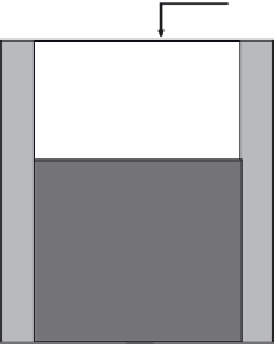Environmental Engineering Reference
In-Depth Information
negligible levels. However, potential adverse environmental impacts must be avoided due
to the unknowns regarding nanoparticle transport.
An example of a nanotreatment remediation site (USEPA OSWER Selected Sites Using
or Testing Nanoparticles for Remediation) is at the BP Prudhoe Bay Unit, North Slope,
AK, abandoned oil ield RCRA Pilot Site. The soil is organic-rich over an alluvial gravel
and was contaminated with TCA and diesel fuel. The maximum initial TCA concentra-
tion was 58,444 μg/kg, TCA reduction was 96% for a shallow test (up to 1.2 m depth) after
1 year of application (mean concentration) whereas for the deep test (up to 2.3 m depth),
TCA reduction was 40%. Treatment and control plots for each delivery method were sub-
jected to identical treatment processes to validate the results. Two different mixing meth-
ods were used: (1) For the shallow test, physical mixing with lake water and (2) for the
deep test, pressurized injection via 20 injection points. The work was performed by PARS
Environmental and Lehigh University.
11.4.3 Electrokinetic Remediation
The electrokinetic remediation process can remove metals and organic contaminants from
low permeability soil, sludge, and dredged sediment. The technique uses electrochemical
and electrokinetic processes to desorb and then remove the contaminants. Electrochemical
remediation uses a low DC current or a low potential gradient to electrodes that are inserted
into the contaminated soil or sediment (Virkutyte et al., 2002). When DC electric ields
are applied to the contaminated soil, ions migrate toward the corresponding electrodes
(Figure 11.5). Cations are attracted to the cathode, and anions to the anode. An electric
gradient initiates movement by electromigration (charged chemicals movement), electro-
osmosis (movement of luid), electrophoresis (charged particle movement), and electrolysis
(chemical reactions due to electric ield) (Rodsand and Acar, 1995). For example, under an
induced electric potential, the anionic form of Cr(VI) migrates toward the anode, whereas
the cationic forms of Cr(III), Ni(II), and Cd(II) migrate toward the cathode. Contaminants
that accumulate at the electrodes are extracted by methods such as pumping water near
+
Anode
-
Cathode
Electrode cell
Anions
Electrode
Cations
Electrode solution
FIGURE 11.5
Electrokinetic treatment of contaminated soil.

















Search WWH ::

Custom Search